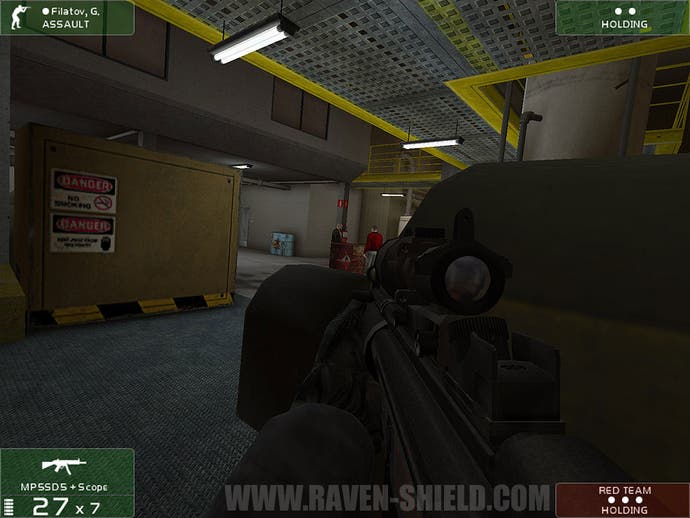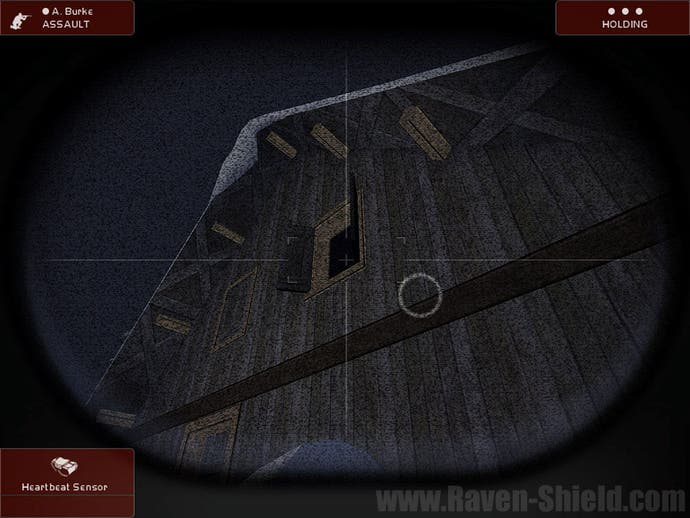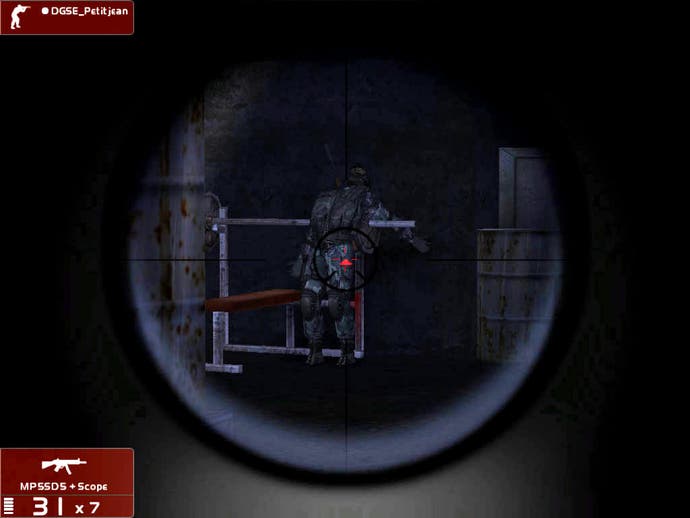Tom Clancy's Rainbow Six 3: Raven Shield
Martin wonders why ravens need shields
Rainbow Six is a true benchmark for the tactical action genre. However Red Storm seemed disappointingly keen to continue milking the first two titles in the series with absolutely no shame, with mission pack after mission pack slowly diluting our enthusiasm for the fine originals. Now, at last, Raven Shield - the sequel to Rogue Spear - sets out to offer fans of the genre what they've been gagging for all these years.

Who need stories when you've got guns?
Rainbow Six games have never been great at storytelling, and Raven Shield is no exception. It attempts to set up the tale of a neo-fascist plot to take over the world or something like that, but it's just a weak frame on which to build a string of missions that have little or no significance to the story. This we aren't too concerned about; we don't play Rainbow Six for the complex, emotional plot or exquisite character development and wouldn't have expected it now. Where the games did need work, though, was in the visuals department, as Red Storm's proprietary engine simply wasn't cutting it against the competition any more.
Thankfully, the employment of next-generation Unreal technology has lent the series a much-needed facelift; the whole game from the environments to the weapon and character models feels a lot more solid than before. The use of rag doll animation on the characters means that downed tangos and soldiers alike crumple to the floor and roll down stairs with convincing aplomb, and when at rest limbs will dangle lifelessly over ledges, all of which enforces a deeper realism that hasn't been present in Rainbow Six titles gone by.
In fact, atmospherically the game has come along leaps and bounds. The lavish textural and structural detail that has been expended on each of the game's maps is impressive, and coupled with the brooding incidental score and ambient sound effects, the game rarely fails to grip.
An assault on a cartel mansion, for example, became wonderfully theatrical as we wormed our way down to a huge, plush lounge area. Muffled opera could be made out ahead, and as we got close and swung the door open we were greeted by a grand piano behind which a terrorist was taking cover, along with a couple of friends on the other side of the room. The radio warnings started up at the same time as the terrorists shouting for backup, and as the firearms began to ring out the piano sang random notes with bullet strikes all to the operatic strains, amounting to an inspiring moment of gameplay. There are little moments like this scattered throughout the game, and it's worth playing through all the missions just to savour them alone.

Tricky
Oddly though there isn't a learning curve as such. You're pretty much thrown in at the deep end, and newcomers to the series are going to be surprised at just how challenging the game can be, particularly with the lack of a mid-mission save feature. Personally, we can do without one, but some are going to see this as a major flaw when they have to restart some of the trickier, more daunting missions over and over.
There is also a startling lack of variety in the scenarios; you'll usually find yourself rescuing hostages, neutralising all the terrorists, rescuing hostages and neutralising all the terrorists, or in one infuriatingly hard mission that recalls the villa mission from Rogue Spear, entering a house and planting bugs on a phone and laptop and exiting again without being discovered. Granted, this is what counter-terrorism teams usually do, but more variety from the "enter building, shoot people, exit building" dynamic would have been welcome.
The implementation of the AI in both your teammates and enemies is again hit or miss, as seems to be the standard for Rainbow Six games. Soldiers still have door navigation issues when a large group of them are trying to fit through, but seem to find their way around each map fairly well when there isn't anything lying around to obstruct them. They are generally adept at covering your back though, and only very rarely lapse into insisting that they all pile through a door and get shot one after another. Enemies seem to exhibit a curious mix of deviousness and cunning; defending themselves effectively before becoming completely oblivious to your presence again - despite the stream of unsilenced assault rifle bullets streaking into the wall mere inches from their faces.

Gunplay
Multiplayer is easily as absorbing as the single player campaign, probably more so, and just about manages to urinate on all contenders from a great height because it's just so damn compulsive. This is what Raven Shield is going to live on for the next couple of years we should imagine, and that's no bad thing.
Nothing can really beat the thrill of the team-based survival matches, but there is also all-against-all survival, a Counter-Strike-style escort-the-VIP (or in this case, pilot) game type, bomb activation/defusing, and hostage-rescue modes to play with, alongside co-operative versions of the single player missions.
The network code is pretty solid when it's not telling you that you have an invalid CD key (Red Storm, sort this out now), and the community has thus far proved to be a polite, co-operative bunch, actually interested in playing the game properly, instead of getting some kind of perverse thrill from filling their buddies with lead [unlike Ghost Recon on Xbox Live, then -grumpy Ed].

Counter-progressive
What is really surprising about Raven Shield though is how little the game has changed in the last five years. Here we have a game that manages to achieve some truly inspirational moments, yet singularly fails to build upon the standard it established. Even the planning stages before each mission remain just as impenetrable as ever and barely changed; you're probably better off just loading the pre-packaged plans as they tend to work well enough. If you're really unhappy with the way a mission pans out, you can always take the time to tweak the tangled mess of waypoints and go-codes, but starting from scratch seems... well, masochistic.
There are some functional improvements, certainly; namely the contextual menu with which to communicate rudimentary orders to your team - to open doors, flashbang suspicious rooms or clear them out, etc - and the replacement of the HUD-based planning map with visual, first-person waypoint indicators was a good move. Also of note is the inclusion of "fluid movement"; toggling this and moving the mouse up, down, left or right allows you to precisely raise or lower your body position, ideal for popping up Time Crisis-style and slaughtering firmly entrenched opposition without getting 'headshotted'. Sadly, though, there's rarely ever a convenient moment to actually use this feature properly, apart from the tutorial.
Overall, there just isn't much evidence to suggest Raven Shield is pushing the tactical action genre forward. We suppose the question is 'should we care?' Probably not. Frankly, Raven Shield is an absolutely tremendous game, and there is no denying it that. We haven't played a more atmospheric single or multiplayer tactical action game since SWAT3, and despite its shortcomings there is still nothing that comes close to rivalling it for sheer breathe-down-your neck tension. It may not drive the genre in a new direction, but it has almost everything you could expect from it, whether you're an anal-retentive gun nut or just an FPS fan up for a weighty challenge. See you in a few months for the first mission pack.

